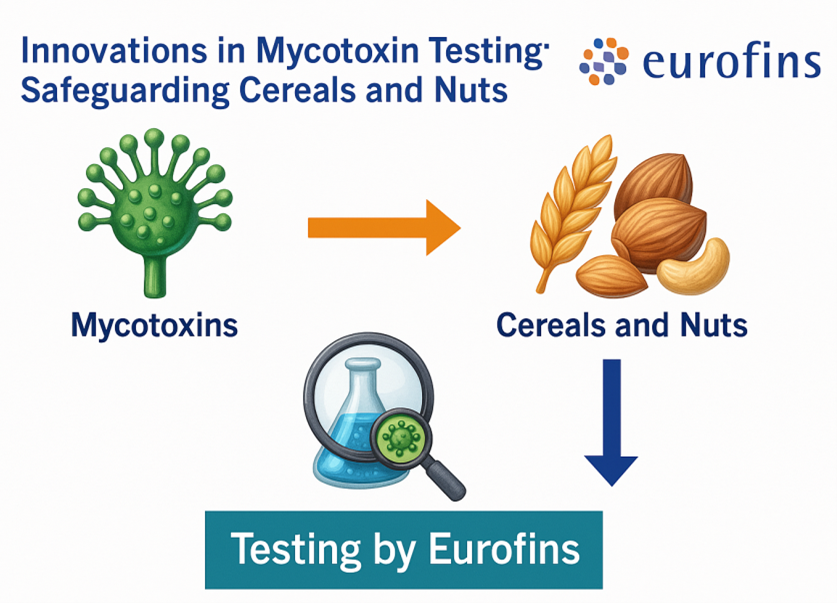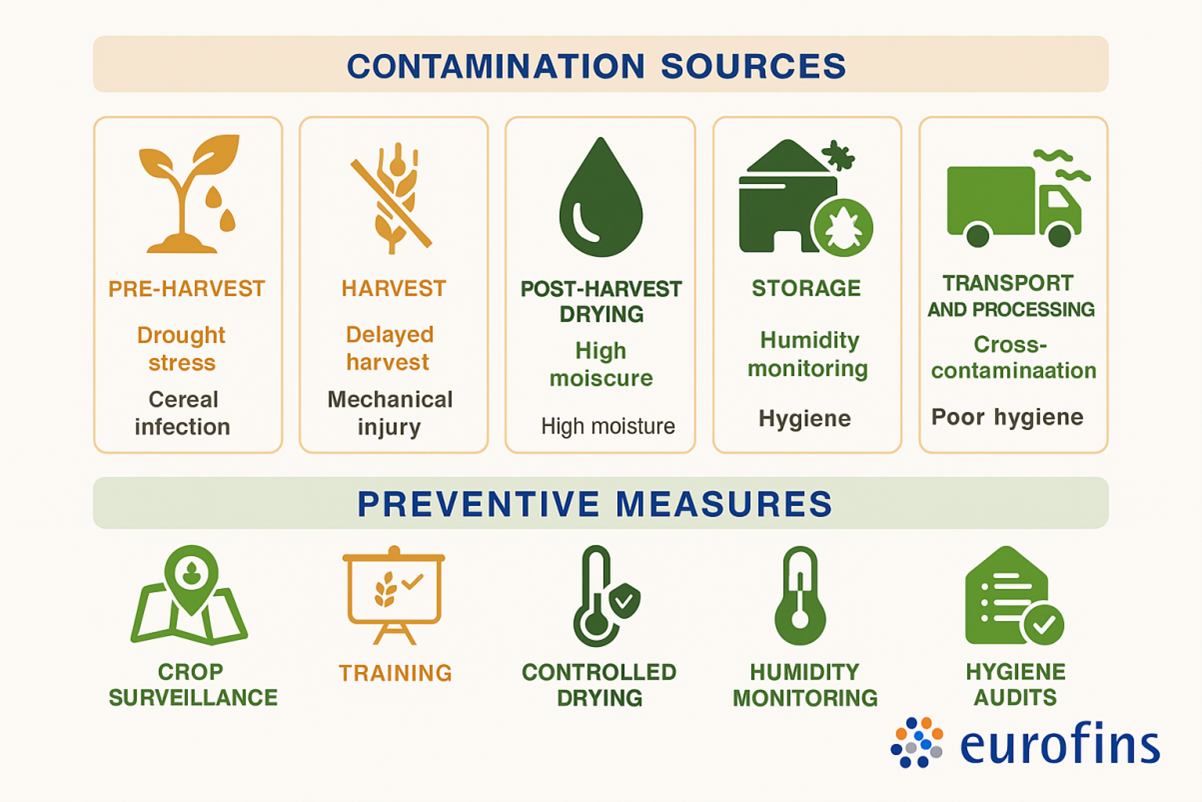Innovations in Mycotoxin Testing: Safeguarding Cereals and Nuts

Introduction
Mycotoxins are toxic, naturally occurring secondary metabolites produced by molds such as Aspergillus, Penicillium, and Fusarium. These contaminants often affect cereals, nuts, and oilseeds during cultivation, harvest, or storage, posing serious health and economic risks. Chronic exposure can lead to hepatotoxic, nephrotoxic, immunosuppressive, and even carcinogenic effects in humans and animals.

At Eurofins, we understand the challenges industries face in detecting and managing mycotoxin contamination. Our global network of ISO/IEC 17025-accredited laboratories utilizes state-of-the-art analytical technology, expert data interpretation, and predictive modeling to safeguard your products and ensure compliance with EU, FSSAI, FDA, and Codex Alimentarius standards.
Why Advanced Mycotoxin Testing Is Crucial
Mycotoxin contamination can occur at any stage of the supply chain, from the field to the finished product. At Eurofins, we provide advanced testing and consultancy services that help you:
- Detect and quantify trace-level contamination in raw materials and final goods.
- Implement preventive control programs aligned with HACCP, ISO 22000, and GFSI systems.
- Comply with multi-jurisdictional regulatory limits across domestic and export markets.
- Prevent costly recalls and protect consumer confidence.
- Build brand trust through transparent certification and traceability solutions.
Our comprehensive mycotoxin services deliver both analytical precision and actionable insights for long-term product integrity.
Major Mycotoxins of Concern
|
Mycotoxin |
Main Producing Fungi |
Common Commodities |
Health Impact |
|
Aflatoxins (B1, B2, G1, G2, M1) |
Aspergillus flavus, A. parasiticus |
Groundnuts, maize, pistachios, milk |
Carcinogenic, hepatotoxic |
|
Ochratoxin A (OTA) |
Aspergillus ochraceus, Penicillium verrucosum |
Cereals, coffee, dried fruits |
Nephrotoxic, carcinogenic |
|
Deoxynivalenol (DON) |
Fusarium graminearum, F. culmorum |
Wheat, barley, oats |
Vomiting, growth retardation |
|
Zearalenone (ZEN) |
Fusarium graminearum, F. roseum |
Maize, barley, sorghum |
Estrogenic effects |
|
Fumonisins (B1, B2, B3) |
Fusarium verticillioides |
Maize, maize products |
Neurotoxic, hepatotoxic |
|
T-2 and HT-2 Toxins |
Fusarium sporotrichioides |
Oats, barley, maize |
Immunotoxic, cytotoxic |
Sources and Pathways of Contamination
Mycotoxin formation can occur throughout the production chain. Eurofins experts help identify contamination pathways and develop preventive action plans to minimize risk.

|
Stage |
Potential Source of Contamination |
Preventive Control Measures |
|
Pre-Harvest |
Drought stress, humidity, fungal infection, insect damage |
Agronomic audits, crop surveillance, weather-linked risk mapping |
|
Harvest |
Delayed harvest, mechanical injury, improper handling |
Training on optimal harvest and sampling techniques |
|
Post-Harvest Drying |
Incomplete drying, high moisture content |
Moisture profiling and controlled drying recommendations |
|
Storage |
High humidity, poor ventilation, pests |
Storage audits, humidity monitoring, and fumigation validation |
|
Transport and Processing |
Cross-contamination, condensation, poor hygiene |
Hygiene audits, packaging validation, and process control testing |
By addressing every stage, Eurofins helps you maintain product integrity and reduce contamination risk before it reaches your customers.
Advanced Testing Technologies
Eurofins offers a suite of innovative technologies designed to provide rapid, precise, and reliable mycotoxin detection.
|
Technology |
Description |
Key Advantages |
Applications |
|
LC-MS/MS (Liquid Chromatography–Tandem Mass Spectrometry) |
Detects multiple mycotoxins simultaneously with high sensitivity. |
Ultra-trace quantification, validated accuracy, multi-matrix capability. |
Cereals, nuts, feed ingredients. |
|
High-Resolution Mass Spectrometry (HRMS) |
Identifies emerging or masked mycotoxins with precise mass accuracy. |
Detects novel toxins, ideal for research and regulatory use. |
Complex food matrices. |
|
ELISA (Enzyme-Linked Immunosorbent Assay) |
Rapid antibody-based detection of specific mycotoxins. |
Economical, suitable for routine batch screening. |
Industrial QA labs. |
|
Lateral Flow Devices (LFDs) |
Portable test strips for on-site screening. |
Fast (5–10 min), minimal training, immediate results. |
Field, port, and warehouse inspections. |
|
AI and Predictive Modelling |
Integration of analytical and environmental data. |
Predicts risk trends, identifies hotspots before contamination occurs. |
Preventive monitoring programs. |
Our laboratories use harmonized testing protocols, ensuring consistent results and comparability across global operations.
Regulatory and Quality Framework
The Food Safety and Standards Authority of India (FSSAI) sets strict limits for mycotoxins in food and feed to safeguard public health. Below is a summarized table of key contaminants and their maximum limits (in µg/kg).
|
S.No |
Contaminant |
Food Article |
Limit (µg/kg) |
|
1 |
Total Aflatoxins |
Cereal and cereal products |
15 |
|
Dried figs |
10 |
||
|
Arecanut or Betelnut |
15 |
||
|
Nuts for further processing |
15 |
||
|
Ready-to-eat nuts |
15 |
||
|
Oilseeds for further processing |
15 |
||
|
Ready-to-eat oilseeds or oil |
15 |
||
|
Pulses |
15 |
||
|
Spices/Spice Mix |
30 |
||
|
Food products containing above items |
20 |
||
|
2 |
Aflatoxin B1 |
Arecanut or Betelnut |
10 |
|
Cereal and cereal products |
10 |
||
|
Dried figs |
10 |
||
|
Nuts for further processing |
10 |
||
|
Ready-to-eat nuts |
10 |
||
|
Oilseeds for further processing |
10 |
||
|
Ready-to-eat oilseeds or oil |
10 |
||
|
Pulses |
10 |
||
|
Spices/Spice Mix |
15 |
||
|
Food products containing above items |
10 |
||
|
3 |
Aflatoxin M1 |
Milk (Liquid) |
0.5 |
|
Skimmed milk powder |
6 |
||
|
Whole milk powder |
4 |
||
|
4 |
Ochratoxin A |
Wheat, rye, barley |
20 |
|
5 |
Patulin |
Apple juice |
50 |
|
Apple juice as ingredient in beverages |
50 |
||
|
6 |
Deoxynivalenol |
Wheat |
1000 |
https://www.fssai.gov.in/upload/uploadfiles/files/Compendium_Contaminants_Regulations_28_01_2022.pdf
https://food.chemlinked.com/news/food-news/india-fssai-revised-limits-contaminants
European union: Commission Regulation (EU) 2023/915 (effective 25 April 2023) replaces Regulation (EC) No 1881/2006 and sets maximum levels for mycotoxins in food and feed. It covers aflatoxins (B1, B2, G1, G2), ochratoxin A, patulin, deoxynivalenol, zearalenone, fumonisins (B1, B2), citrinin, and ergot alkaloids (via ergot sclerotia limits). Feed limits focus on aflatoxin B1 and ergot alkaloids. Commission Recommendation 2013/165/EU provides guidance (not mandatory) for T-2 and HT-2 toxins in cereals and cereal products for both food and feed.
Detailed limits vary by food type (e.g., cereals, nuts, milk) and are specified in the regulation's annexes. For full text, refer to the official EU document.
https://eur-lex.europa.eu/legal-content/en/TXT/?uri=CELEX%3A32023R0915
Risk Management and Mitigation Strategies
At Eurofins, we believe in proactive contamination control. Our comprehensive risk management services include:
Preventive Agricultural Practices
- Field monitoring using weather-based predictive models.
- Use of biocontrol strains of Aspergillus flavus.
- Soil management and crop rotation strategies.
Post-Harvest Control
- Moisture reduction to safe storage levels.
- Antifungal packaging and humidity control audits.
Analytical Surveillance
- Periodic sampling at key supply chain points.
- Trend analysis to identify seasonal or regional contamination patterns.
Compliance Verification
- Certification support for EU, FDA, and export documentation.
- Validation of decontamination and detoxification measures.
Emerging Trends and Future Innovations
At Eurofins, we continuously invest in research and development to bring clients the most advanced detection and prevention solutions, including:
- Nanobiosensors for rapid, real-time mycotoxin detection.
- Blockchain-based traceability for transparent supply chains.
- Cold plasma and ozone detoxification for sustainable decontamination.
- Multi-residue analysis combining pesticide and mycotoxin testing.
Why Choose Eurofins for Mycotoxin Testing
- Global network of ISO/IEC 17025-accredited laboratories.
- Comprehensive analytical coverage from aflatoxins to emerging toxins.
- Expert scientific and regulatory guidance tailored to export needs.
- Rapid turnaround times and harmonized reporting.
- Integrated contaminant risk assessment, including chemical, microbiological, and sensory testing.
Partner with Eurofins Food Testing
Safeguard your cereals, nuts, and food ingredients with Eurofins’ advanced mycotoxin detection and prevention services. Our experts can design a customized monitoring and mitigation program to help you meet global food safety standards and protect your brand.
Enquire now: https://www.eurofins.in/food-testing/enquire-now/


